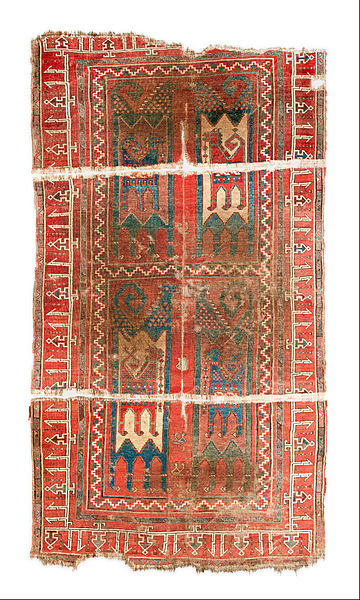Anatolian rug is a term of convenience, commonly used today to denote rugs and carpets woven in Anatolia and its adjacent regions. Geographically, its area of production can be compared to the territories which were historically dominated by the Ottoman Empire. It denotes a knotted, pile-woven floor or wall covering which is produced for home use, local sale, and export, and religious purpose. Together with the flat-woven kilim, Anatolian rugs represent an essential part of the regional culture, which is officially understood as the Culture of Turkey today, and derives from the ethnic, religious and cultural pluralism of one of the most ancient centres of human civilisation.
Anatolian double-niche rug, Konya region, circa 1750–1800. LACMA M.2004.32
Bergama rug, west Anatolia, first half of 18th century.
17th-century Ottoman velvet cushion cover, with stylized carnation motifs. Floral motifs were common in Ottoman art.
Animal carpet, dated to the 11th–13th century, Museum of Islamic Art, Doha
A kilim is a flat tapestry-woven carpet or rug traditionally produced in countries of the former Persian Empire, including Iran, the Balkans and the Turkic countries. Kilims can be purely decorative or can function as prayer rugs. Modern kilims are popular floor coverings in Western households.
Hotamis Kilim (detail), central Anatolia, early 19th century
Gilim Iran museum
Modern galim
Diagram of kilim slit weave technique, showing how the weft threads of each color are wound back from the color boundary, leaving a slit








